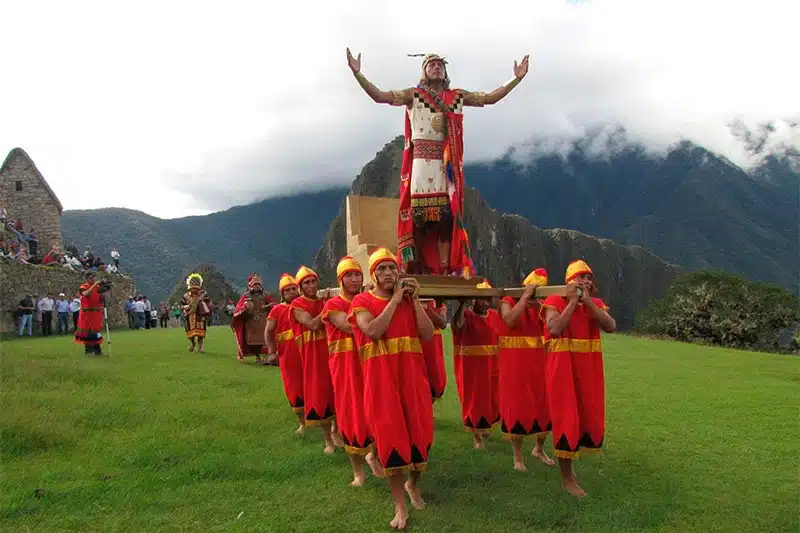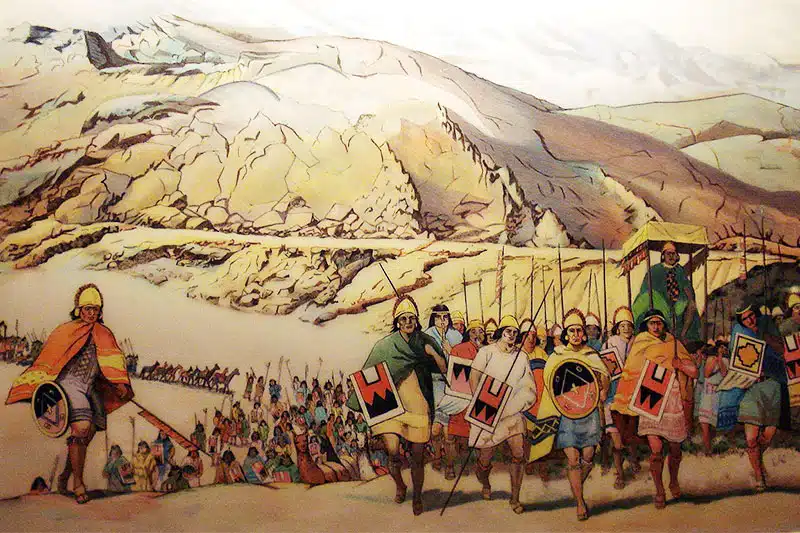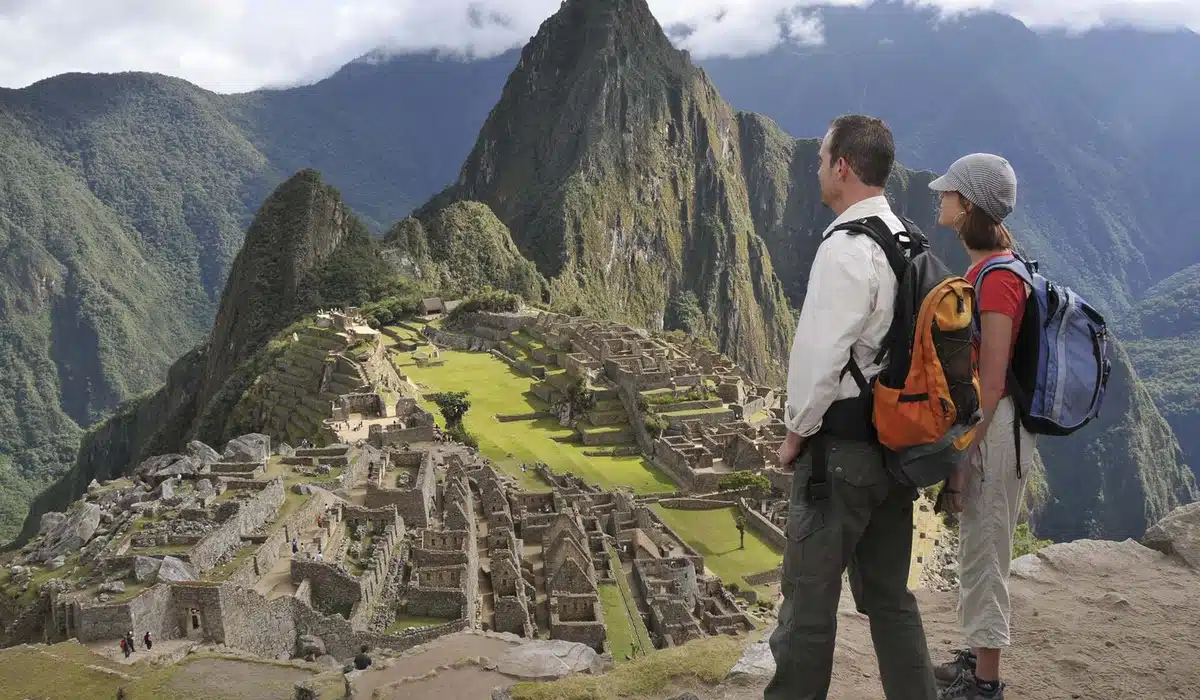Inca history: the 10 most important historical facts
The Incas were the largest empire in America, covering a territory that extended to regions of present-day Peru, Ecuador, Colombia, Bolivia, Argentina and Chile. Its capital was the city of Cusco, from where its roads (qhapac ñan) started to all its provinces. Throughout their more than four hundred years of history, the Incas achieved great development in ceramics, social organization, metallurgy, textiles and, above all, architecture. Learn about the ten most important events in Inca history.
Tabla de Contenido
The mythical migration to the Cusco valley
- The Incas were an original ethnic group from the highlands surrounding Lake Titicaca (current region of Puno, Peru.
- Approximately at the end of the 12th century, the Incas were threatened by the ferocious Aymara ethnic groups. Thus they sought to find a new territory in which to settle.
- The path they took was south, towards the current region of Cusco. There are few historical sources about this migration. Most of the information comes from oral tradition: the legend of Manco Capac and Mama Ocllo and the legend of the Ayar Brothers.
- In both legends it is narrated in a mythical way how the Incas settled in Cusco after a historical migration ordered by their gods: the sun (Inti).
- As a result, the Incas settled in the Cusco Valley where they would eventually found the largest empire on the South American continent
Manco Capac and Mama Ocllo
- Although there are few historical sources and its existence is more in the mythological realm, Manco Cápac (? – 1230) is considered the founder and first Inca ruler.
- He was the one who led the great Inca migration to the Cusco valley and, in addition, he was the one who managed to strengthen alliances with the families who lived in this place by transmitting his knowledge in agriculture, architecture and government.
- His wife and sister was Mama Ocllo, also a mythical figure. It was she who accompanied Manco Cápac in the great migration to the Cusco Valley and who taught women the arts of textiles, ceramics, agriculture, etc.
- The government of Manco Cápac (late 12th century) was a first great impetus for the consolidation of the Incas in Cusco. It is believed that he ordered the construction of the Inticancha, the Temple of the Sun that would later be called Coricancha.
- Today his figure is fundamental to understanding the history of the Incas. It is believed that Manco Cápac was the son of the sun, the god Inti.

The victory against the Chancas
- In the middle of the 15th century (1440) the Incas faced the fearsome Chancas for control of the southern Andean territory. Both cultures had a significant army and fought to achieve great expansion.
- The Incas were governed by Huiracocha who, fearful of the Chanca invasion of Cusco, fled to his palace in the Sacred Valley.
- In 1438 the Chanca warrior Astoy Huaraca was ready to invade Cusco and destroy the Incas. There were 50 thousand warriors who had a reputation for being bloodthirsty and invincible. They had never been defeated.
- Faced with the imminent Inca defeat, the figure of Cusi Yupanqui, son of Huiracocha, emerged who led the Inca people asking them not to flee, to stay to defend their lands, to fight for Cusco.
- The Incas, with the help of other neighboring ethnic groups and the leadership of Cusi Yupanqui, managed to push back the Chancas to finally defeat them in the battle of Yahuarpampa (pampa of blood) and achieve the great expansion of their territory.
The foundation of Tahuantinsuyo
- The Inca victory against the Chancas in 1438 was transcendental in achieving great expansion, important alliances with neighboring ethnic groups and thus the creation of the Inca empire, the Tahuantinsuyo.
- The figure behind this great revolution in Inca history was the young prince Cusi Yupanqui who became the first Inca emperor called Pachacutec since then.
- The change was not only territorial. Pachacutec ordered the teaching of Quechua in all the new conquered towns. In this way it managed to impose itself culturally in the new provinces annexed to its territory.
- In addition, thousands of kilometers of roads (the qhapac ñan) were created, which linked Cusco (the capital of the empire) with the rest of the territories.
- As a result of this great change in the Inca government, the foundations were laid for the largest empire in South America, which covered large regions of present-day Peru, Ecuador, Colombia, Bolivia, Chile and Argentina.

Pachacutec
- Pachacutec was the great architect of the creation of the Inca empire. His government is considered the best in Inca history and ancient Peru.
- It is estimated that he lived between 1418 – 1471 AD. He was the ninth ruler of the Inca ethnic group but the first emperor of Tahuantinsuyo.
- Pachacutec comes from a compound word in the Quechua language that means ‘the Inca of the change of the course of the earth’.
- Among the historical events that Pachacutec achieved, the following stand out: the historic victory against the Chanca army, the founding of the Tahuantinsuyo empire, the construction of Coricancha, the construction of sections of qhapac ñan, the construction of Machu Picchu, the teaching of Quechua in all the regions and the reorganization of the state.
- After his death, Pachacutec’s mummy was taken to the temple of lightning (Tococache) where he continued to be worshiped and respected by the Inca people.
The civil war between Huáscar and Atahualpa
- Huáscar was the twelfth Inca ruler, who established his palace in the city of Cusco. His brother Atahualpa, who was not officially elected Inca emperor, resided in the city of Quito.
- Little by little Atahualpa grew in power thanks to a large army that even competed in numbers with that of Huáscar in Cusco. Thus, Huáscar, fearful of this power, ordered the assassination of Atahualpa, which triggered a great civil war between the brothers.
- The Inca civil war lasted from 1529 to 1533. It is estimated that more than 1 million people died on both sides.
- According to the Cusco chronicler Inca Garcilaso de la Vega, 150 thousand people died in the battle of Hatun Xauxa alone.
- In 1533, while he was imprisoned by the Spanish in Cajamarca, Atahualpa ordered the death of Huáscar.

The capture and death of Atahualpa
- In 1532 the Inca sapa Atahualpa was captured in Cajamarca by the Spanish armies led by Francisco Pizarro.
- After a time as a prisoner (he was captured on November 16, 1532 and died on July 26, 1533) he decided to offer a price for his ransom: two rooms of silver and one of gold as far as his hand could reach. Pizarro accepted.
- After this, for months what is known as the highest rescue in history was brought from all corners of the Tahuantinsuyo.
- How much pay? The calculation may vary depending on the season. It is stated that there were 6 thousand kilos of gold. In 1991, the College of Economists of Peru estimated that this amount represented 647,047 million dollars (Peru’s public debt in 2021 is only 80,748 million dollars).
- The rest is known history: Pizarro did not free him and Atahualpa was sentenced to death. After that, Pizarro traveled to Cusco where, in the long run, he would end the Inca empire. Principio del formulario.
The taking of Cusco
- The taking or conquest of Cusco was the arrival of the Spanish to the city of Cusco in 1533, then capital of the Inca empire.
- After the death of Atahualpa, the Spanish army marched towards Cusco without first sending emissaries and winning some battles against the Atahualpa army.
- However, Francisco Pizarro had to be sure of being well received in Cusco, a place in misgovernance. To do this, he made an agreement with Túpac Hualpa (brother of Atahualpa) who agreed to be the Inca successor to the throne.
- But Túpac Chualpa was finally poisoned by followers of Atahualpa, so Pizarro negotiated with Manco Inca his arrival in Cusco. The young Manco Inca was 20 years old and the son of Huayna Cápac. Given the promises of continuation of the Inca lineage, I trust Pizarro. This is how it helped him enter Cusco.
- Upon Pizarro’s arrival in Cusco he was supported by Huáscar’s followers in Cusco (a large part of the nobility). This is how he managed to impose his conditions on Manco Inca, who realized Pizarro’s true intentions.
- Upon Pizarro’s arrival in Cusco, the Inca temples decorated with gold, silver and precious stones were looted.

The rebellion of Manco Inca
- After the capture of Cusco by the Spanish led by Francisco Pizarro, Manco Inca realized the real intentions of the invaders. Thus, an army is formed and bloody confrontations are carried out in historic places such as Sacsayhuamán, Chinchero and Ollantaytambo.
- Unfortunately, as a result of the use of firearms, several Inca walls and buildings were destroyed.
- Manco Inca’s army fled along the route of the Vilcanota River, deepening into the thick jungle until forming a small Inca government in Vilcabamba. From there Manco Inca fought the Spanish army.
- The Incas who fought the Spanish from there were called ‘The rebel Incas of Vilcabamba’. It is estimated that they fought the Spanish between 1537 and 1572.
- In 1545 Manco Inca was murdered by an Almagrist whom he assisted in Vilcabamba as a result of clashes against Pizarrists. Upon his death, he was succeeded by Sayri Túpac Inca, Titu Cusi Yupanqui and Túpac Amaru, who confronted and agreed with the Spanish until 1572.
The death of Túpac Amaru I
- After the death of Titu Cusi Yupanqui, the figure of Túpac Amaru I emerged who ignored the pact with the Spanish and confronted them from Vilcabamba determined to restore the Inca Government.
- Túpac Amaru, translated from the Quechua language, means ‘Fire Serpent’.
- The Spanish sought to negotiate unsuccessfully with the Inca rebel who fled deep into the jungle before the Spanish ambush.
- The Spanish destroyed the citadel of Vitcos, located Vilcabamba, and pursued the Inca until finally capturing him.
- Túpac Amaru was captured and taken to the city of Cusco. There he was beheaded in May 1572. With the death of Túpac Amaru, the Inca resistance in Vilcabamba ended. That is, the Spanish consolidated their domains in the one already formed in the Viceroyalty of Peru.
Te Sugerimos leer . . .
The San Blas neighborhood is known as the 'bohemian neighborhood'. It is located just 15 minutes walk from the Plaza de Armas of Cusco. In addition to the Plaza and the colonial church of San Blas, there you can see the historic craft shops of the Mérida, Olave and Mendivil families. You can also spend a moment of tranquility, away from the intense commerce of the city center. And the best thing is that a visit to this Cusco space is free for everyone. Learn more!
Inti Raymi is the festival of the sun that dates back to the time of the Incas. Today in the city of Cusco, the residents rescued this tradition from their ancestors to perform an impressive staging every June 24 in three stages: the Coricancha, the Plaza de Armas and Sacsayhuaman. Although there are admission tickets for these shows, it is also possible to see them for free. Learn more!
The Sapantiana aqueduct in Cusco is one of the most recent free tourist attractions in Cusco. It is a colonial construction with high walls and arches, down whose stairs the water of a channeled stream descends. This allows you to get excellent photographs of the place. Entry to this construction is free for all visitors. Getting there is also free since you can go on foot. Learn more!
Intipunku is a Quechua word that means 'Gate of the sun'. Perhaps the most famous is the one located at the top of Machupicchu. However, in Ollantaytambo – the Sacred Valley of the Incas – there is also an Intipunku made by the Incas, which offers beautiful landscapes and a lot of history. The visit is free for all tourists. But to do this you must complete a challenging short hiking route. Learn more!
Cusco is one of the best tourist destinations in South America. Every year it is visited by more than 2 million people. Machu Picchu is your main destination. However, the capital of the Incas offers more: natural mountainous landscapes, treks, adventures, cold nights, parties, experiential tourism and more. For your climate, geography and experiences, it is essential to carry a suitcase with the appropriate clothing and utensils. Know what to bring on your trip to Cusco!
Cusco is a tourist destination available for all types of prices and experiences. Tourists who want an A-1 service can hire luxury hotels, all-inclusive trains and the best restaurants in the city. Tourists who want a lower-budget experience can choose one of the seven affordable restaurants we present below.






